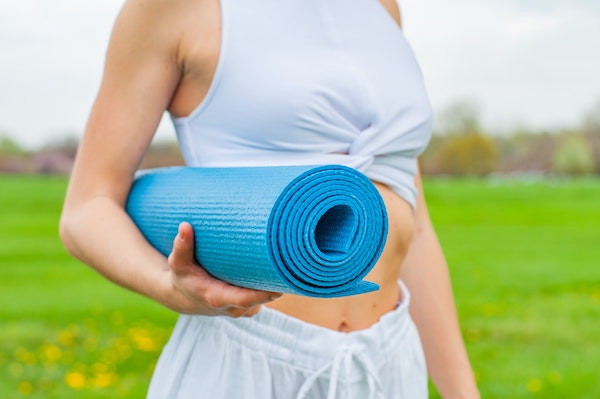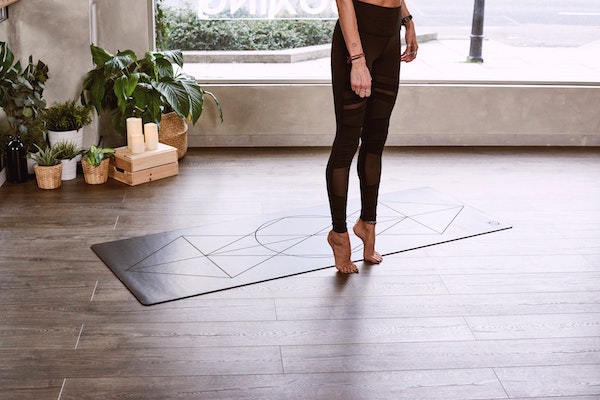
If you’re aiming to be healthier, no matter what’s motivating you to change — a vacation, keeping up with your kids, or even an upcoming life insurance medical exam — you’ve probably run up against some obstacles in your pursuit of fitness.
For example, some people would have you believe there are certain (expensive) must-haves for exercise: overpriced tank tops, a monthly gym membership, and tons of high-end at-home equipment.
When it comes to yoga, you might be wondering: Do I actually need a yoga mat?
Though it may fly in the face of everything you’ve seen on Instagram, yoga requires exactly zero special equipment.
You do not need a yoga mat to practice yoga in a pinch, though it’s best if you eventually invest in even an inexpensive mat. Carpets and rugs are the best alternative, though they can be slippery in some poses and are an injury risk.
Standing poses can be done on almost any flooring, but avoid doing full yoga on a surface with too much give (like a bed) or too little give (hardwood floors).
So if you’re looking to use yoga as your vehicle to get healthier, here’s how you can get it done, no mat required.
(And check out some of the benefits of yoga here.)
Yoga: Defined
Knowing what you really need and what you don’t will remove some of the mysticism and get you practicing yoga safely in no time.
Yoga means to unite; to connect what’s happening in the mind and the body.
Any time you bring awareness and intention to what you’re doing, exercise or otherwise, you’re doing yoga!
(It’s not just about intricate poses like twisted triangle or pyramid. Even something as simple as focusing on your breath can be yoga.)
With such a simplistic definition for an activity that’s been around for thousands of years, today’s fitness gurus have really made practicing yoga seem quite complicated.
What’s a yoga mat and do I need one?
If you’re ready to practice yoga but don’t have a mat (or find yourself somewhere without yours), don’t throw in the towel.
A yoga mat’s main purpose is simply to provide grip and a slight cushion.
If you find yourself without one, you can still do most of what you’d do in a normal practice. Try this:
- Take off your socks. You normally remove socks whether you have a mat or not, but especially without one, you want to create as much slip-resistance as possible.
- Instead of finding a substitute mat like a towel or blanket, both of which can get bunched up and actually make you more likely to fall, find your home’s most cushioned carpet.
- Stick to poses and sequences which are easy on your joints since you don’t have the extra padding.
Single poses like Ragdoll, Tree, Mountain and many, many more are perfect for your mat-free yoga practice.
If you’re ready to incorporate asana sequences, or the flowing postures of yoga, here’s a yoga sequence you can try sans mat.
Yoga off the mat (Good and bad yoga mat alternatives)

So if a mat’s not necessary, does that mean all yoga poses are safe everywhere?
While you can practice gentle stretching and yogic breathing anywhere, there are some precautions you should take with where and how you practice more advanced postures.
Should you practice yoga on your bed?
Just because your bed feels like one big cushion, don’t take that as your cue to practice your favorite yoga inversions there.
It may seem like the more cushion the better, especially for poses for which there’s potential to tumble, but sometimes the opposite is actually true.
The magic of advanced postures begins in the firmness and support of the ground and your ability to simultaneously “root down to rise up.”
If you’re sinking down and into your surface, the integrity of your spine will be compromised, and then you’ll definitely need a massage after your workout.
Your foundation, or the ground you anchor into as you move your body, matters.
If you’re looking to practice your yoga from the comfort of your bed, keep it to relaxing, restorative poses or breathwork, and not as a time-saving solution.
Can you do yoga on the floor with no mat?
If you really find yourself in a bind and don’t have a mat or a carpeted area to exercise, it’s not a good idea to do a full yoga practice on a raw hardwood or concrete floor.
Certain standing poses are fine (Tree, Mountain, Ragdoll), but anything that puts your knees, back, or other key joints in contact with the hard floor could be an injury risk.
Besides, the discomfort from the hard floor is bound to take you out of your breath and disrupt your focus.
That’s not very yoga-like!
Yoga blanket vs yoga mat
If you’ve ever been to a yoga studio, you may have noticed all the props: bolsters, blocks, straps, blankets, and more.
Some may seem similar, like blankets and mats, but don’t confuse them for one another.
Yoga mats and yoga blankets are definitely not interchangeable.
Your yoga mat grips flooring to keep you from slipping around during your practice and to give your body a little extra support.
Yoga blankets can be used for extra support and protection, for your knees, for example, in Table Top.
But they are also used for their more obvious purpose: providing extra warmth and a feeling of coziness in restful postures.
Like previously mentioned, trying to use a blanket in place of a mat will cause some issues, like bunching and sliding, so just forego the mat instead of trying to substitute.
Doing yoga on the carpet or rug
A thick carpet is probably the best yoga mat substitute you’re likely to find in your home, a hotel room, or wherever you happen to be.
It’s not a perfect replacement, however, because:
- Even with socks off, you’ll slip more on a carpet than a mat
- Mats define your practice space and help you align your body, carpets are large and sprawling
- Your mat can be easily wiped down after a practice, while carpets are often full of hair and will soak up your sweat!
However, carpet is probably the best choice if you want to practice yoga and don’t have access to a mat.
How much do yoga mats cost, and can I just get a cheap one?
An inexpensive yoga mat is better than none at all in most cases.
As we wrote above, all a mat does is prevent slippage and a little bit of cushion for certain poses.
While high-end mats like the Liforme are amazing and practice-changing, you can do just fine with a more budget-friendly option.
You can get a functional, quality yoga mat for as little as $10-20.
Here’s a great affordable choice on Amazon that even comes with a carrying strap!
Wrapping Up
To sum up:
No, you don’t need a yoga mat to get started with yoga or practice in a pinch.
However, if you plan on advancing your practice and learning difficult moves, a mat is the best surface available. You can get one for as little as $10 and invest in a nicer one when you’re ready.
In the meantime, the carpet is a halfway decent place to practice yoga, but be aware that you may slip in some poses! And don’t put yourself at risk by lying down or practicing on a hard surface (though standing poses are fine).
The best part of realizing yoga doesn’t require special equipment is that you can begin to bridge the gap from viewing yoga as something you do in a studio to something that can enhance your everyday life, no matter where that might be.
That means no unnecessary equipment and no outrageous gym contracts.
Yoga is meant to be lived out, so be brave and take your yoga off the mat and out into the world!
This post was written by Leslie Kiel and edited by Evan Porter. Leslie writes for CompareLifeInsurance.com. She’s a mom of three, a yoga teacher, and eagerly takes opportunities to practice yoga no matter where life takes her.